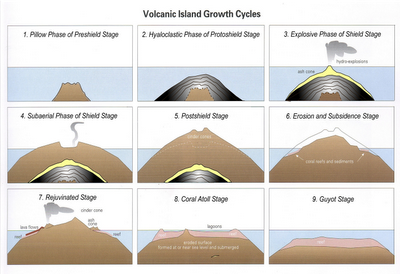9 April 2010
Volcano Vocab: Guyot
Posted by Jessica Ball
I don’t want to steal the thunder of any of the Skepchicks (especially Evelyn, who’s doing a fantastic job on the Geology Word of the Week feature), but I thought I’d start a bi-weekly post on obscure or specialized volcanology words. (Yes, it’s really just an easy way for me to post, since I’ve got the Glossary of Geology sitting here and all I have to do is flip a page to get a post idea, but I’ll try to include a little discussion along with the posts.) We’ll see if I’m any more successful with this weekly feature than I was the last time.
So what’s the first word o’ the half-week? By dint of me opening to the glossary of a volcanology textbook and pointing blindly: Guyot!
A guyot (“gee-oh”) is basically a flat-topped seamount, or underwater volcano. The glossary in Bardintzeff & McBirney’s Volcanology (2000) adds a bit about why it’s got a flat top:
A submarine volcano with a flat top produced by wave erosion before the island was submerged.
A guyot is one of the stages in the life cycle of an ocean island volcano, and the form occurs when a volcano is no longer actively growing and unable to replace what is lost to the erosive force of wind and waves. Here’s a diagram to illustrate:



 Jessica Ball is a volcanologist at the U.S. Geological Survey, researching volcanic hydrothermal systems and stability, and doing science communication for the California Volcano Observatory. She previously worked at the Geological Society of America's Washington DC Policy Office, learning about the intersection of Earth science and legislative affairs. Her Mendenhall postdoc and PhD focused on how water affects the stability of volcanoes, and involved both field investigations and numerical modeling applications. Her blogging covers a range of topics, from her experiences in academic geosciences to science outreach and communication to her field and lab work in volcanology.
Jessica Ball is a volcanologist at the U.S. Geological Survey, researching volcanic hydrothermal systems and stability, and doing science communication for the California Volcano Observatory. She previously worked at the Geological Society of America's Washington DC Policy Office, learning about the intersection of Earth science and legislative affairs. Her Mendenhall postdoc and PhD focused on how water affects the stability of volcanoes, and involved both field investigations and numerical modeling applications. Her blogging covers a range of topics, from her experiences in academic geosciences to science outreach and communication to her field and lab work in volcanology.
Looks a lot like a Tuya! (table top mountains common in Iceland) but without the glacier. How important is the choral component to the definition? Could a Guyot be a Guyot without the reef? Cool stuff!
It does! (Too bad you missed the Pegrum yesterday – tuyas were the topic du jour.) Maybe the reef part is just sort of a symptom of a lot of volcanic islands being in warm water? I'd have to read up on other guyots…
My understanding is that these hills are eroded scarps at the head of an old landslide on the flank of Mauna Loa. As far as seeing guyots, I think we have some of them in the Sierra Nevada foothills, but seeing as they got subducted, baked, squished, highly deformed and faulted, they don't look like guyots anymore!